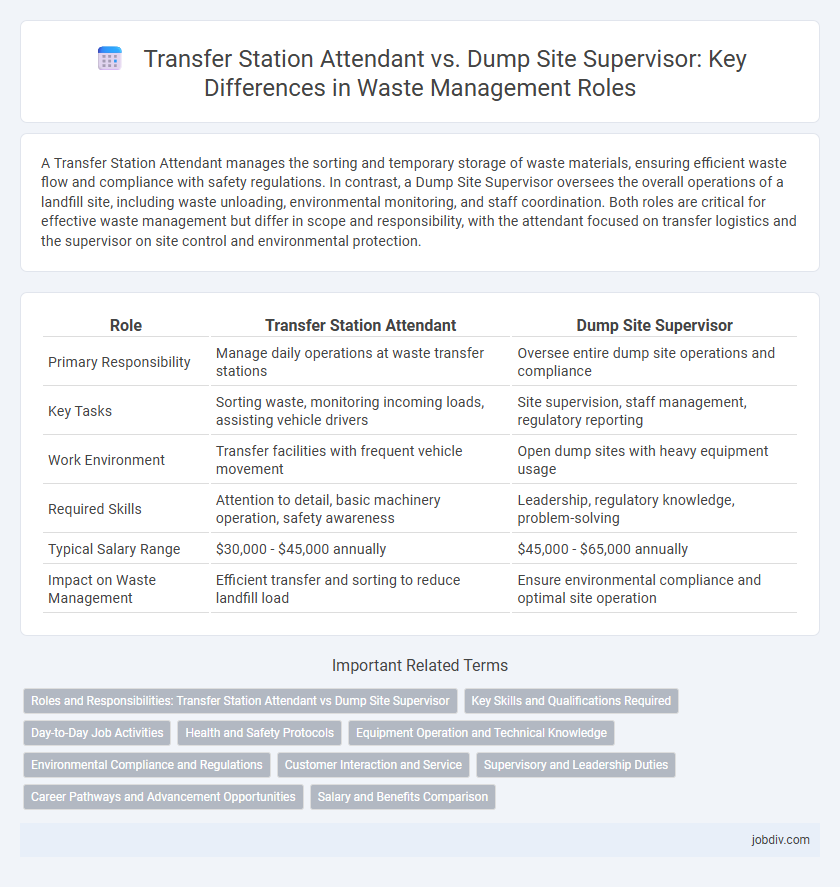A Transfer Station Attendant manages the sorting and temporary storage of waste materials, ensuring efficient waste flow and compliance with safety regulations. In contrast, a Dump Site Supervisor oversees the overall operations of a landfill site, including waste unloading, environmental monitoring, and staff coordination. Both roles are critical for effective waste management but differ in scope and responsibility, with the attendant focused on transfer logistics and the supervisor on site control and environmental protection.
Table of Comparison
| Role | Transfer Station Attendant | Dump Site Supervisor |
|---|---|---|
| Primary Responsibility | Manage daily operations at waste transfer stations | Oversee entire dump site operations and compliance |
| Key Tasks | Sorting waste, monitoring incoming loads, assisting vehicle drivers | Site supervision, staff management, regulatory reporting |
| Work Environment | Transfer facilities with frequent vehicle movement | Open dump sites with heavy equipment usage |
| Required Skills | Attention to detail, basic machinery operation, safety awareness | Leadership, regulatory knowledge, problem-solving |
| Typical Salary Range | $30,000 - $45,000 annually | $45,000 - $65,000 annually |
| Impact on Waste Management | Efficient transfer and sorting to reduce landfill load | Ensure environmental compliance and optimal site operation |
Roles and Responsibilities: Transfer Station Attendant vs Dump Site Supervisor
Transfer Station Attendants manage the intake, sorting, and temporary storage of waste at transfer facilities, ensuring proper categorization and safety protocols are followed. Dump Site Supervisors oversee the entire landfill or dump site operations, including waste disposal, environmental compliance, and site maintenance to prevent contamination. While attendants focus on operational tasks at transfer points, supervisors have broader responsibility for site management and regulatory adherence.
Key Skills and Qualifications Required
Transfer Station Attendants require strong organizational skills, knowledge of waste sorting procedures, and basic machinery operation to manage incoming waste efficiently. Dump Site Supervisors need advanced leadership abilities, expertise in environmental regulations, and proficiency in site safety management to oversee operations and ensure compliance. Both roles demand physical stamina, attention to detail, and the ability to enforce safety protocols in waste handling environments.
Day-to-Day Job Activities
Transfer Station Attendants manage incoming waste by sorting materials, operating compactors, and maintaining site cleanliness to ensure efficient processing. Dump Site Supervisors oversee large-scale waste disposal operations, coordinate heavy machinery use, enforce safety protocols, and monitor landfill compliance with environmental regulations. Both roles demand meticulous record-keeping and real-time problem-solving to optimize waste flow and site safety.
Health and Safety Protocols
Transfer Station Attendants implement routine health and safety protocols such as personal protective equipment usage, spill containment, and monitoring hazardous waste handling to reduce on-site risks. Dump Site Supervisors enforce compliance with environmental regulations, supervise waste disposal processes, and conduct safety audits to prevent accidents and exposure to harmful substances. Both roles prioritize training in emergency response and ensure proper sanitation to maintain safe working environments in waste management facilities.
Equipment Operation and Technical Knowledge
Transfer Station Attendants specialize in operating compactors, balers, and conveyor systems efficiently, requiring solid technical knowledge of equipment maintenance and safety protocols. Dump Site Supervisors oversee heavy machinery such as bulldozers, excavators, and loaders, demanding advanced mechanical skills and expertise in environmental regulations. Both roles necessitate proficiency in equipment operation, but Dump Site Supervisors hold greater responsibility for managing complex technical systems and ensuring compliance with waste management standards.
Environmental Compliance and Regulations
Transfer Station Attendants primarily ensure proper sorting and handling of recyclable and waste materials to maintain environmental compliance with local regulations, minimizing contamination and promoting sustainability. Dump Site Supervisors oversee waste disposal operations, enforcing adherence to environmental permits, managing landfill usage, and monitoring site activities to prevent illegal dumping and pollution. Both roles are critical for regulatory compliance under EPA standards and local environmental protection laws, contributing to effective waste management and environmental safety.
Customer Interaction and Service
Transfer Station Attendants engage directly with customers by guiding waste drop-offs and addressing immediate inquiries, ensuring smooth and efficient site operations. Dump Site Supervisors oversee overall site management but typically interact with customers in resolving escalated issues or implementing customer service policies. Both roles emphasize safety and compliance, yet Transfer Station Attendants prioritize frontline customer service, while Supervisors handle strategic oversight and conflict resolution.
Supervisory and Leadership Duties
A Transfer Station Attendant primarily manages daily operational tasks, ensuring efficient waste sorting and handling, while maintaining safety protocols at the facility. The Dump Site Supervisor oversees multiple attendants, coordinates site activities, enforces environmental regulations, and leads training initiatives to enhance team performance. Effective leadership in a dump site supervisor role involves strategic planning, workforce management, and ensuring regulatory compliance across all waste transfer operations.
Career Pathways and Advancement Opportunities
Transfer Station Attendants typically gain hands-on experience managing incoming waste and sorting materials, serving as entry-level roles in the waste management industry. Dump Site Supervisors oversee daily operations, coordinate staff, and ensure compliance with environmental regulations, requiring advanced knowledge and leadership skills. Career advancement often follows a progression from Transfer Station Attendant to Dump Site Supervisor, with opportunities to move into environmental compliance or waste management coordination positions.
Salary and Benefits Comparison
Transfer Station Attendants typically earn an average salary ranging from $30,000 to $40,000 annually, with benefits including health insurance, retirement plans, and paid time off. Dump Site Supervisors command higher salaries, often between $45,000 and $60,000 per year, reflecting their supervisory responsibilities and greater experience requirements, along with enhanced benefits such as leadership bonuses, advanced healthcare options, and professional development allowances. Salary differences also stem from job complexity and geographic location, making Dump Site Supervisor roles more financially rewarding in major metropolitan areas.
Transfer Station Attendant vs Dump Site Supervisor Infographic

 jobdiv.com
jobdiv.com